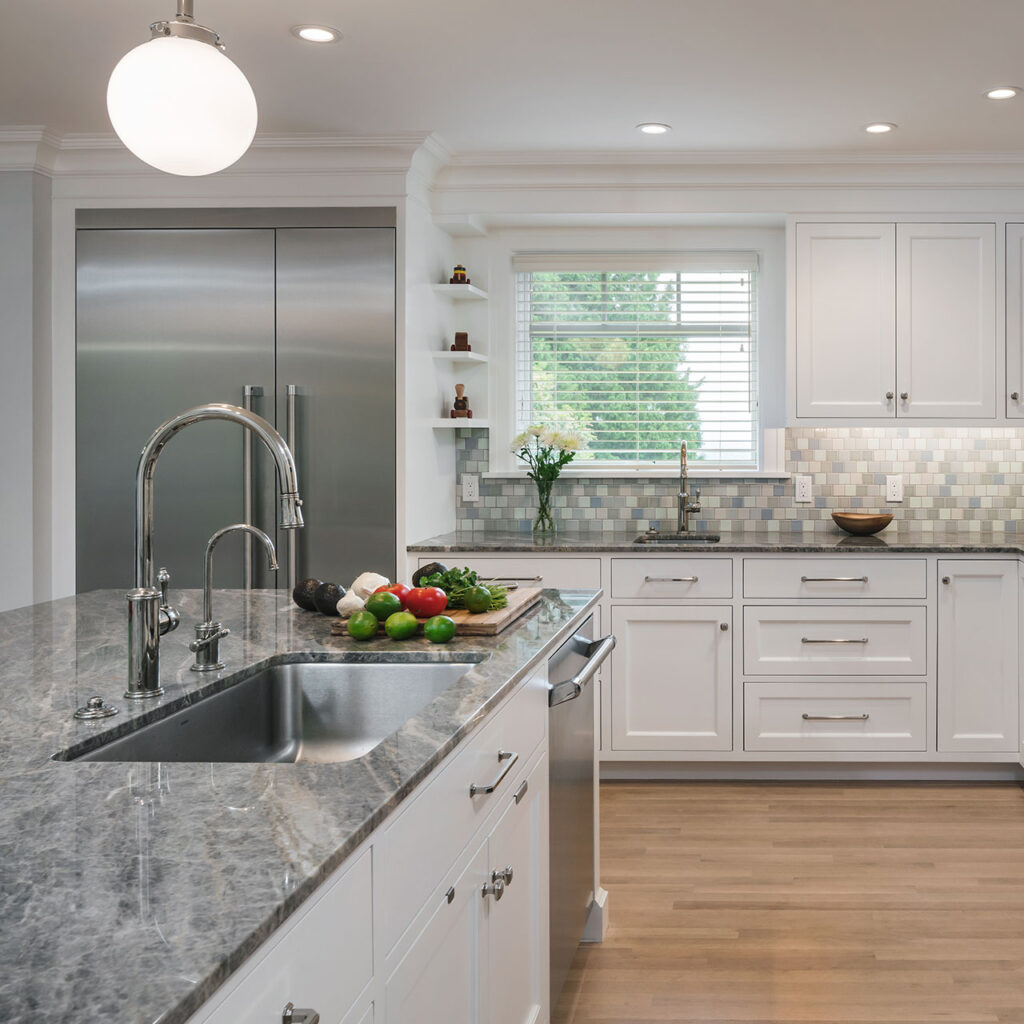
One of the most challenging parts of the kitchen design process is decision-making. Why? Because from materials, colors, and finishes to light fixtures, hardware, and appliances, there are so many selection decisions to make. And so many options for each selection. Our job is to help you avoid analysis paralysis. We want to guide you through the process and provide you with the resources you need to make the best decisions for your home and family.
Appliance selection is critical to achieving your dream kitchen and supporting your daily food routines, especially the refrigerator. This is often the largest appliance in your kitchen and its location can drive the layout. The Christie Architecture team helps lay the groundwork for this selection. We work through space planning challenges and talk about the look and feel you are trying to achieve. We can also connect you with our favorite appliance stores and sales reps when it is time for you to make your fridge purchase.
Here are some things to think about when choosing a new full-size fridge for your kitchen project. (We’ll tackle under-counter fridges in a future blog post.)
Daily Fridge Requirements
As you consider your refrigeration needs, think about your lifestyle. Your shopping, cooking, and eating habits can help guide your selection process.
- Do you eat a lot of fruits and vegetables? If so, do you need a refrigerator with produce drawers? How deep are those drawers? Some fridges don’t have a drawer that will even fit a head of lettuce.
- Do you drink a lot of beverages? How much space will that take up? You may want to consider a second fridge dedicated only to beverages.
- Do you need a place for gallon jugs of milk? People are used to putting milk in the fridge door, but a one-gallon jug will not fit in the door of a built-in fridge, so it’s going to have to take up shelf space.
- Are you a freezer family? According to Derek Berg of Eastbank Appliances in Portland, Oregon, freezer requirements are the biggest point of consideration as people evaluate refrigerator options. Do you need more fridge space or freezer space or an equal amount of both? Do you want a single deep freezer drawer where all frozen items are piled on top of each other? Or do you want two freezer drawers? Do you want freezer items at waist height or eye level? These preferences will help you decide if you should opt for an upper fridge with bottom freezer or a side-by-side configuration. Side-by-side models typically have more freezer space and are more common in larger families. And, if you really need a lot of freezer space, consider having a second freezer in the basement or garage.
Size Matters
From the refrigerator’s capacity and height to how much space it will occupy in your kitchen, there are important size and layout considerations to address that impact the planning and daily use of your fridge.
How much space do you really need in a refrigerator? This is a capacity question you need to consider. Fridge manufacturers list the capacity in their specs in cubic feet. A 22 cubic foot fridge means you could fill it with 22 cubic feet of water.
What is important to know is that two fridges that are rated at 22 cubic feet can be totally different on the inside. One may not have a drawer deep enough for the head of lettuce we mentioned, but another will.
According to Berg, “Some brands maximize the space so much better than others. You have to see refrigerators in person to truly understand how much space there is. You can have up to 30% more capacity in one compared to another, even though they are both rated the same.”
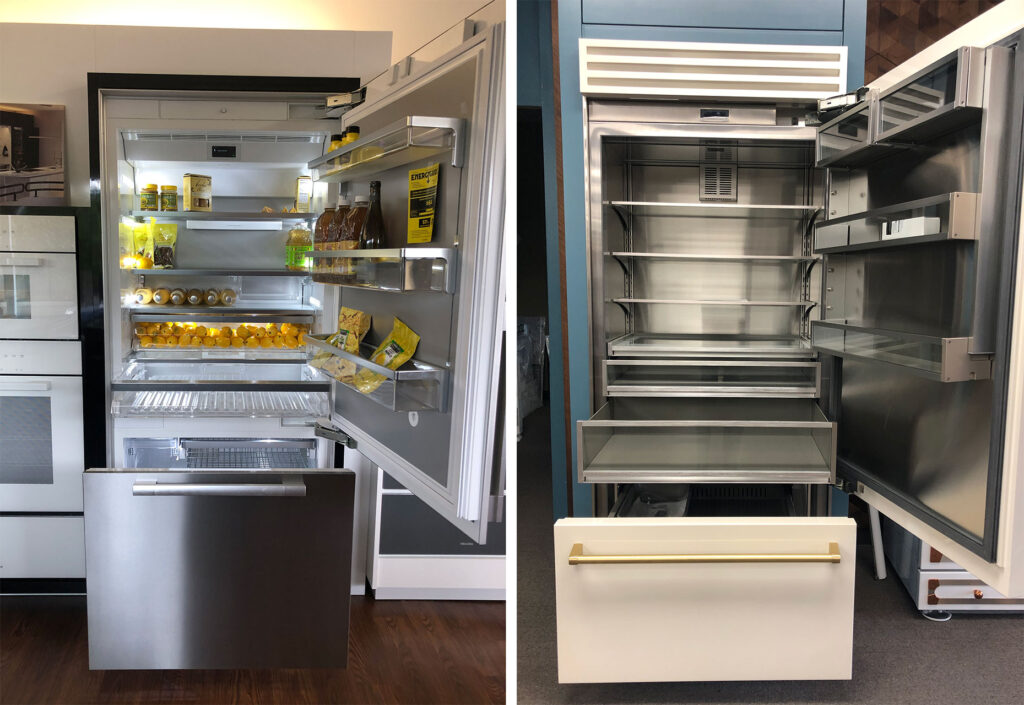
Berg highly recommends in-person shopping in order to look at the layout. You need to envision what kind of produce and food you will be storing and decide if it’s compatible with the brands you’re evaluating. “It is important to touch and feel the appliances,” says Berg. “You can’t just buy it off the internet and expect to know what you’re getting.”
How big is your kitchen and what is the layout?
While a big refrigerator may seem appealing, the reality is a small kitchen won’t properly accommodate a 48-inch wide fridge. And if you live in an older home, can you even get a larger fridge through the front door? We help you work through all of these space planning challenges and considerations.
We think about how the fridge door swings into your space. When you open the refrigerator door how does that impact the use of other appliances or interfere with circulation? The depth, width, and door swing are important details to consider in the kitchen layout.
And don’t forget about the height!
How tall are you? What is your reach? Built-in, fully integrated fridges have the compressor on the bottom – that means the upper shelf is over some people’s heads. Can you reach up there? Or can you even see what’s on the top shelf?
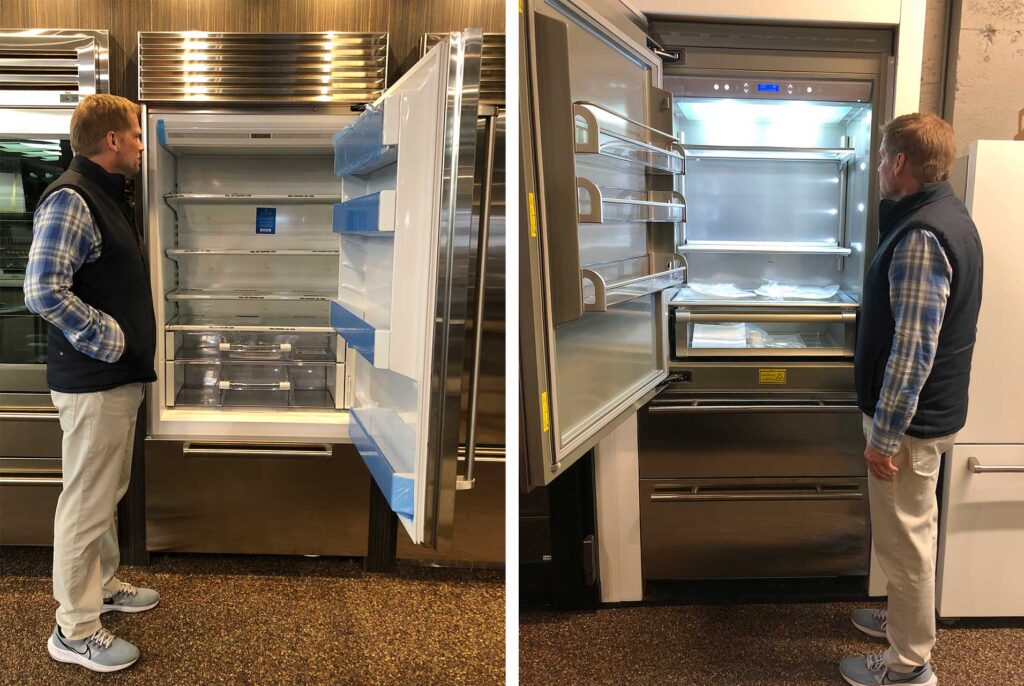
“When some people open up this type of fridge, they immediately say no way! I can’t even see up there,” says Berg.
Love the Look
As you have been paging through magazines or social posts, no doubt you have noted the look and feel of the numerous full-size refrigerators on the market—standard, counter-depth, classic built-in, or fully integrated built-in. The big question is, do you want to see the fridge or do you want it to disappear into the cabinetry?
If you want to see your fridge, your finish options include stainless steel, white, black, or even a trendy color. If you want the refrigerator to disappear, then you can make it match the same finish as the adjacent cabinets. This is called panel-ready and is available on built-in fridges. The cabinet maker builds and installs the panel custom to each particular make and model of fridge.
“We love the look of the fully integrated panels. The reveals can be as tight as our standard cabinet reveals, which looks amazing,” says cabinetmaker Kevin Roggenkamp of On the Level Custom Cabinetry.
Water & ice features
When you think about grabbing a glass of ice-cold water, do you trust your tap or do you want your fridge to be a water source? Many fridge models come with a water dispenser in the fridge as well as an ice maker in the freezer. You need to decide if you want those features accessible on the outside of the door.
A thru-door dispenser is available on almost any style of fridge–standard, cabinet depth or built-in. (Although you probably don’t want one on a fully- integrated panel door since the whole point of that design detail is to conceal the fridge.)
While this feature provides a convenience some people may find desirable, there are a few cons to consider. First is the impact on food storage. The mechanics for thru-door dispensers take up a lot of door space, meaning less room for storing food items. When you look at refrigerators on the sales floor you will see how much space you are sacrificing.
Berg also advises that this feature tends to be a problem area in the lifespan of the fridge. “An ice dispenser located in a fridge door is likely to have problems, since you are putting a mini ice maker into your fridge. Whereas, a dispenser located in a freezer door is less likely to have problems. The ice is already being made in the freezer.”
If you want a dispenser then the side-by-side configuration instead of the bottom freezer will be the best selection.
Let’s explore your options
We’ve talked about a lot of fridge details, but let’s dig a little deeper. Determining the type of refrigerator (standard, counter-depth, or built-in) you want impacts a lot of design decisions. It drives the form and function–the look and feel–of your kitchen and can even influence the design of other areas of your home.

Standard
A standard refrigerator is what most of us grew up with—the good ole freezer on the top model that everyone used to have. It is not seen as much anymore because homeowners don’t want a fridge that sticks out in front of the cabinetry and/or they don’t have space to build a deep cabinet for it. They are less expensive and mostly found at big box stores, but honestly these days they are more often used to store beer in the garage.
Counter-depth – also known as cabinet depth
First, let’s set the record straight. These names are misleading because only the fridge “box” is counter-depth. When you put the doors on it, the doors stick out approximately four inches beyond the face of the counter or cabinets.
For those who are looking for the math, a 25-inch deep box + 4-inch doors = 29 total inches. Cabinets are typically only 25 inches, so you see the sides of the doors. The reality is, the doors must stick out due to the engineering of the hinges. If the fridge was shoved in flush with the cabinets, it wouldn’t open.
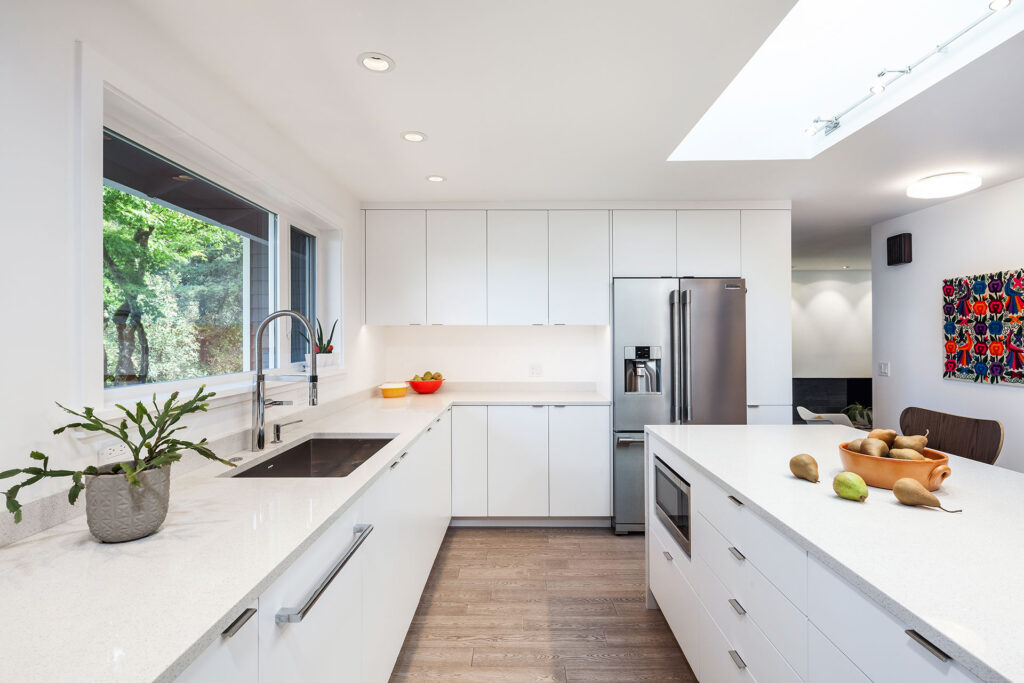
With that said, this is the most common fridge in a kitchen these days. It’s not as expensive as a built-in but doesn’t stick out as far as the old standard model. It is still a freestanding fridge, so you can slide it out of place to clean underneath or access the plumbing and electrical on the wall behind.
You will recognize these stainless steel selections from many magazine photos and we have several clients (Hawkridge Modern, Eastmoreland Remodel, Alameda Update, Concordia Renovation) who have opted for a 36-inch wide French-style upper fridge with a freezer drawer below.
Built-Ins
A built-in fridge is essentially a fridge that is flush or almost flush with the adjacent cabinets. It has a shallower box than a counter-depth fridge. They are literally built into the cabinetry as they are screwed to the sides of the adjacent cabinets and have anti-tip brackets. You can’t just pull this fridge out to dust underneath. When you start to mix and match units your mind will be blown with hundreds of options—endless design possibilities.
There are two styles of built-in fridges: classic and fully-integrated. The classic style sticks out from the adjacent cabinets about two inches and has a half-inch gap between the fridge doors and the adjacent cabinets. The fully-integrated style is truly flush with the adjacent cabinets and has a one-eighth-inch gap between the fridge doors and the adjacent cabinets.
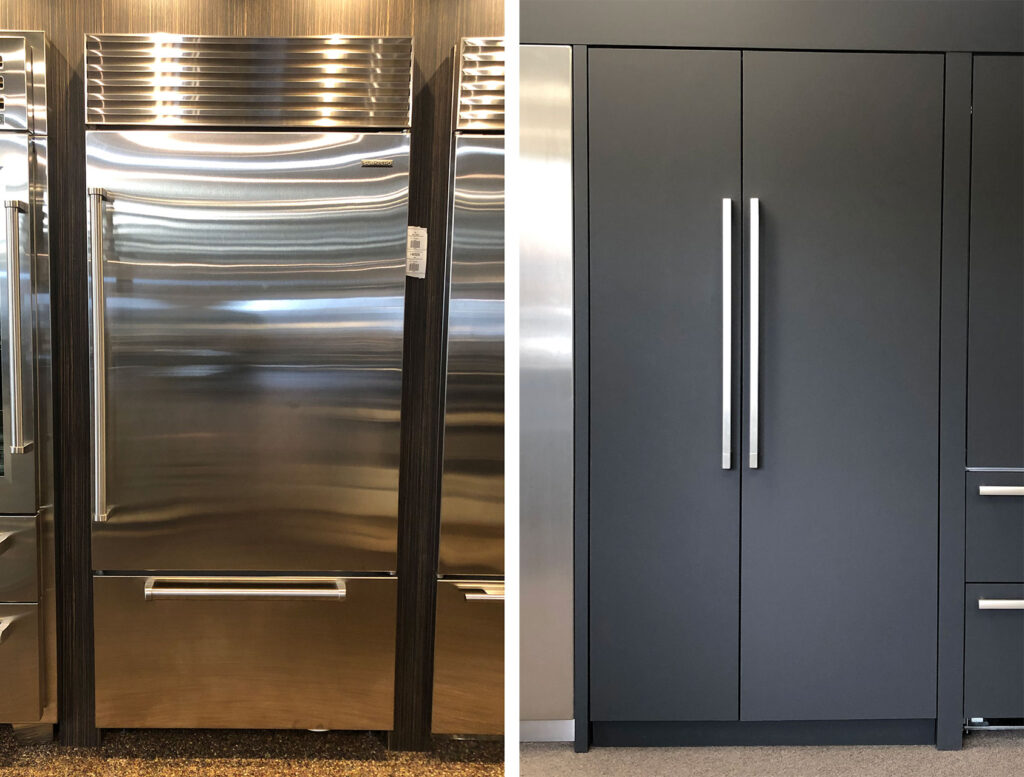
Here are a few more reasons one of these options may be right for you:
Built-In – Classic Style
- You want a built-in look but are okay with the fridge being somewhat of a focal point. It’s a big piece of stainless steel in your kitchen.
- You like a more traditional, heavier kitchen appliance look.
- You’re a shorter person and want a top compressor. It is easier to see the contents and access your food because the top shelf isn’t so high.
- It has more capacity than a bottom compressor fridge.
- You’re okay with the half-inch gap between the fridge doors and the cabinetry. This might bug some people.
It should be noted that a classic style built-in fridge CAN be flush with the adjacent cabinets IF the cabinets are built deeper than typical cabinets. This requires some up-front planning. However, you will still have the half-inch gap between the fridge and cabinet doors.
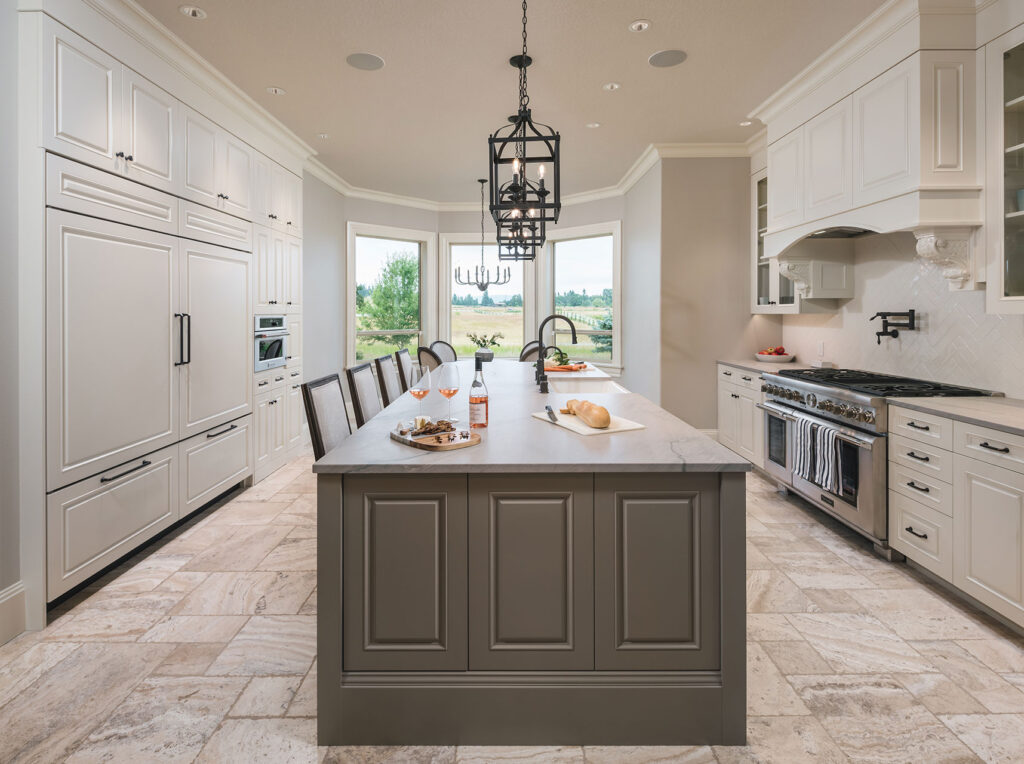
Built-In – Fully Integrated
- You want your fridge to disappear.
- You are looking to achieve a contemporary kitchen design.
- You are tall and/or don’t have a problem reaching the high top shelf due to the bottom compressor.
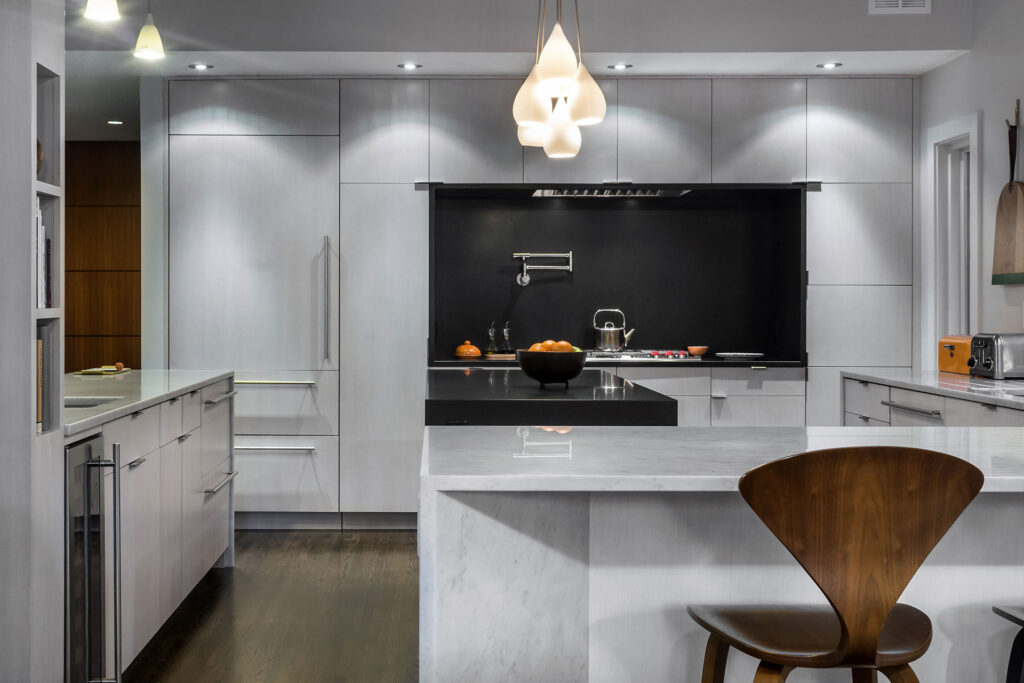
Explore some more fully-integrated options some of our clients selected at Riverview Midcentury (a single, 36-inch wide, French upper fridge and drawer freezer at bottom—panel ready) and Hillside House (one 18-inch freezer column and one 30-inch fridge column—stainless).
What is your picture-perfect choice? The right finish to see and be seen or a sleek and savvy disguise?
Budget-friendly or go all in?
Money matters with every kitchen project, so how do you want to make the most of your investment? What is your appliance budget?
We mentioned all of the options and decision-making, well here is a big range for you. Refrigerators can cost anywhere from $700 to $15,000 for a single unit. When you start combining units, the sky’s the limit on the look but that will also impact the price. From the look and feel to the longevity of the appliance, there are factors that influence this wide cost range and ways to plan for the future.
For example, if you really want that $13k built-in fridge but can’t afford it now, you can pre-plan for one. Design the adjacent cabinetry so that you install the $2,500 fridge now and when it breaks in ten years, you can simply modify the cabinets and put in the $13k model. You can preplan for the electrical needs of the future model as well.
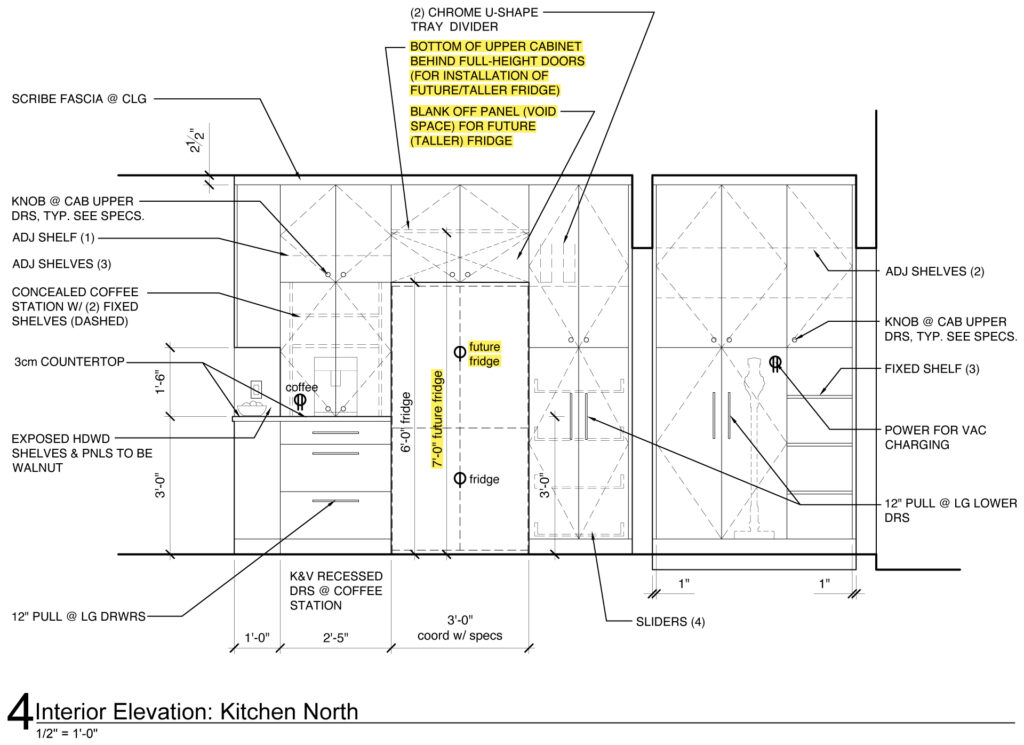
How long will a fridge last?
When it comes to the life expectancy of a new refrigerator, there is a wide range, just like cost, from ten to over 30 years.
A key factor that impacts the cost and lifespan is the refrigerator parts—the components. Our go-to resource Berg says to talk to the salesperson about what components are used and ask about component integrity. “Make sure you ask about the components when purchasing a fridge, especially an expensive fridge because they are not all the same. Some pricey fridges use cheap components. If the salesperson doesn’t know what components are used, that’s a red flag,” says Berg.
According to Berg, the component that usually fails is the heat exchanger. On a less expensive fridge, it is likely to fail within 10 years. And when this component fails, it is not worth fixing because there is more than one on a fridge (usually three). “If one goes, another is probably going to go as well,” says Berg. “They are about $2,000 each, so at that point, it’s not worth fixing.”
You can literally see the difference when you compare a cheap and a high-quality heat exchanger side by side. The high-quality ones look almost like a car radiator—heavy, sturdy, and well put together. A cheap one is found on all standard and counter-depth fridges and SOME built-in fridges. You have to be careful when you pay for a built-in fridge that you’re getting one with a high-quality heat exchanger. When buying a built-in fridge, don’t try to save $2,000 in this area because likely the components are not the same compared to a fridge that is slightly more money. You may save money now, but the heat exchanger will likely fail within 10 years and then you have to replace the entire fridge. The most expensive built-in fridges have a high quality heat exchanger and their lifespan is at least 30 years.
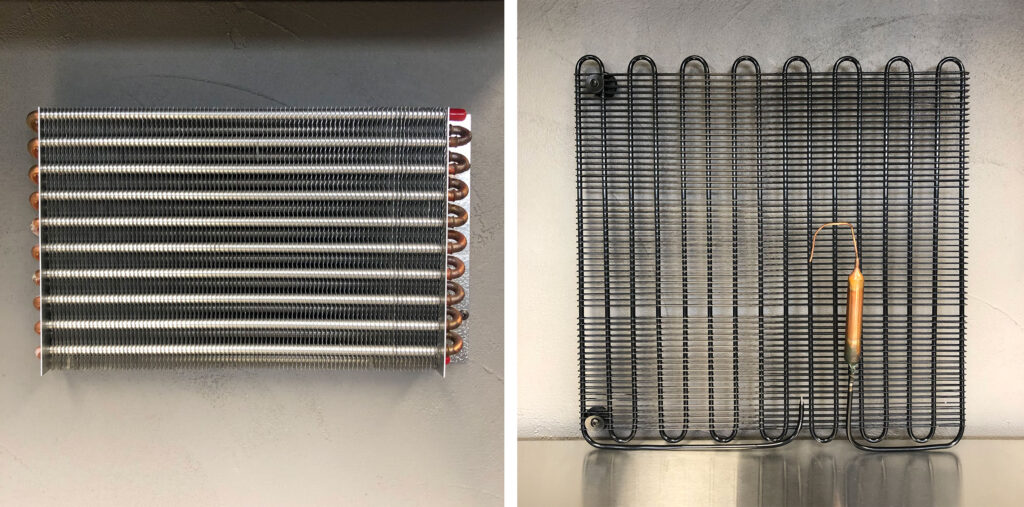
Berg says, “Trying to save $2,000 on a built-in fridge now is the worst thing you can do.”
Breaking down the pros and cons
As you can see there is a lot to consider for this one appliance decision. Here is a chart to break down the refrigerator details and help you weigh the pros and cons of selecting a standard, counter-depth, or built-in.
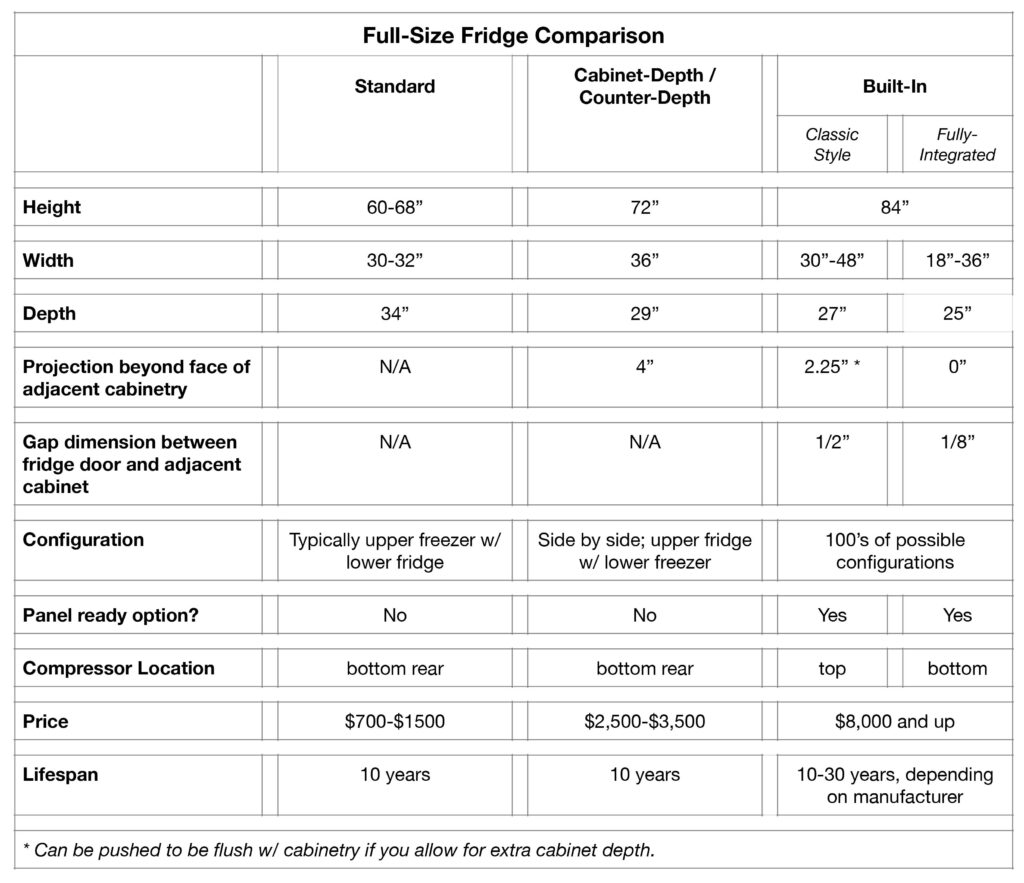
Perfectly Planned
Aside from all of the above information, there are other ways the Christie Architecture team can help with your fridge selection process.
First and foremost, we can establish the best layout for your kitchen and tell you what size fridge(s) will fit. We don’t pick your fridge for you, but we give you guidance about what will fit and function best in your kitchen. We then send you to a salesperson to choose your fridge because only you know what will best support your lifestyle.
Based on your selection, we then think about the whole picture. We coordinate the locations of all the appliances and make sure there are no conflicts—between appliances, the swing of appliance doors, and adjacent walls, cabinetry, etc. We make sure that you can open the fridge door fully because if you locate it too close to an adjacent wall, you can’t open the door all the way. If that happens, we promise that you won’t be happy.
We draw the fridge (and all of the appliances) in detail and coordinate it with the cabinetry. We draw the panels (if necessary) and show you 2D and 3D drawings so you can really understand what your kitchen will look like.
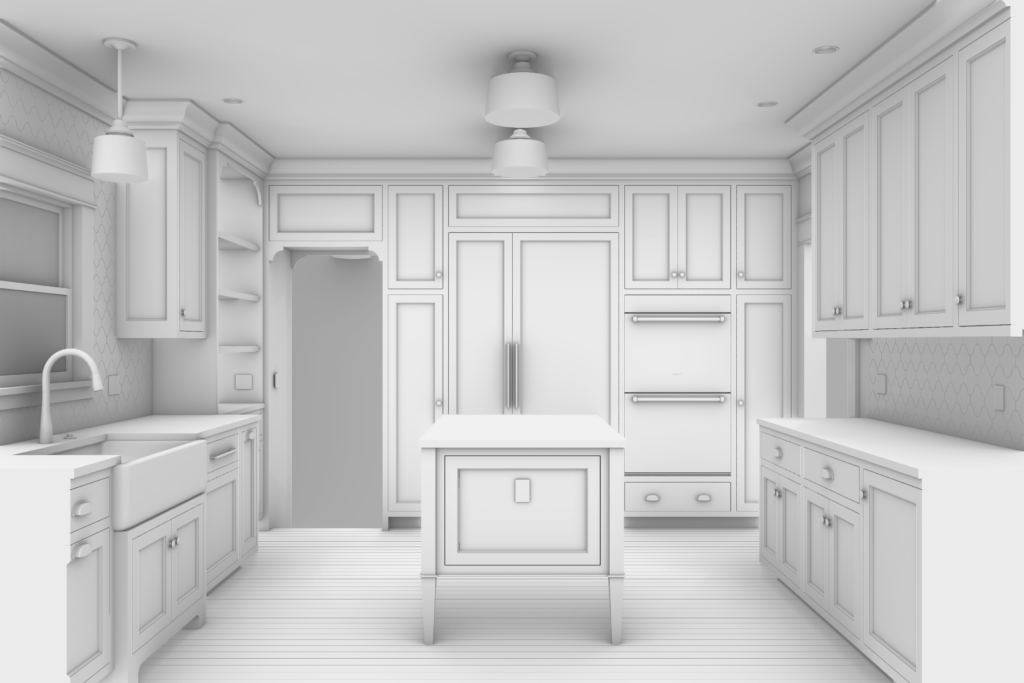
Don’t feel overwhelmed by your fridge options, give us a call so we can walk you through the process and get you one step closer to your dream kitchen.


